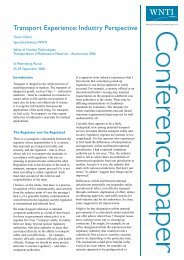sub form - World Nuclear Transport Institute
sub form - World Nuclear Transport Institute
sub form - World Nuclear Transport Institute
You also want an ePaper? Increase the reach of your titles
YUMPU automatically turns print PDFs into web optimized ePapers that Google loves.
WNTI<br />
W O R L D N U C L E A R T R A N S P O RT I N S T I T U T E<br />
GOOD PRACTICE GUIDE<br />
Good Practice for the Securing<br />
of Drums of Uranium Ore Concentrate<br />
in 20’ ISO Containers<br />
Dedicated to the safe, efficient and reliable transport of radioactive materials
home<br />
contents<br />
Good Practice for the Securing of Drums of<br />
Uranium Ore Concentrate in 20’ ISO Containers<br />
Table of contents<br />
1.0 Introduction 5<br />
2.0 General 6<br />
3.0 Loading and Securing 7<br />
4.0 Examples of Drums Secured in ISO Containers 8<br />
5.0 Examples of Calculations to determine the G-load on the securing system 9<br />
5.1. Longitudinal Force 9<br />
6.0 Securing of Drums of Uranium Ore Concentrate in 20’ ISO Container – Vertical Restraint 10<br />
6.1. IAEA TS G-1 – Guidance Material 10<br />
6.2. <strong>World</strong> <strong>Nuclear</strong> <strong>Transport</strong> <strong>Institute</strong> 11<br />
6.3. IMO Guidelines 11<br />
6.4. US DOT 49CFR 12<br />
6.5. <strong>Transport</strong> Canada’s Regulations 12<br />
6.6. American Association of Railroads 13<br />
(CN and CP also require con<strong>form</strong>ation with these standards)<br />
6.7. Practical Cargo Securing 13<br />
6.8. ISO Containers<br />
6.9. Container Handbook – Published by GDV The German Insurer 13<br />
6.10. Japanese Requirements 14<br />
6.11. Summary 15<br />
3
home<br />
contents<br />
This publication is intended as a guide only. The official documents<br />
cited in the text must be consulted for a definitive description of their<br />
purpose and contents.<br />
First Edition published in August 2011<br />
by <strong>World</strong> <strong>Nuclear</strong> <strong>Transport</strong> <strong>Institute</strong>,<br />
Remo House,<br />
310-312, Regent Street,<br />
London,<br />
W1B 3AX<br />
© <strong>World</strong> <strong>Nuclear</strong> <strong>Transport</strong> Limited, 2011<br />
4
home contents 1. Introduction<br />
1.0 Introduction<br />
This guide is intended to provide some methods for loading<br />
drums inside ISO containers for shipment by rail, road and<br />
sea. Loading of uranium concentrate must con<strong>form</strong> to the<br />
regulations of the agency of authority of the countries<br />
within which the shipment moves. This document will<br />
provide a brief overview of some of these requirements.<br />
It is important to properly secure drums inside ISO containers<br />
as the container may move in multiple directions during<br />
transport. During a container journey, normal transport<br />
forces may shift an unsecured load to exert excessive<br />
pressure against the nose, rear doors or side walls. Drums<br />
that are improperly blocked and braced can shift to one side<br />
of the container and cause the container to lean on the<br />
flatcar or truck trailer which may cause the container to<br />
sideswipe or even cause an accident. Weight of the drums<br />
that is concentrated in a small area and not properly<br />
distributed throughout the container can cause the<br />
container floor to collapse during handling.<br />
5
home contents 2. General<br />
2.0 General<br />
The following steps provide a safe method of loading drums<br />
inside an ISO container.<br />
1) The ISO container should be clean, have sound roof,<br />
sides and end walls, smooth floor and snug fitting<br />
doors. There should not be any obvious damage,<br />
distress, weakened parts or weakened sections.<br />
Please refer to the WNTI Standard Uranium<br />
Concentrates - Industry Good Practices for ISO<br />
Containers in Multimodal <strong>Transport</strong>s for more details.<br />
2) Plan the loading of the drums in the ISO container<br />
to prevent damage to the drums and equipment.<br />
3) The loaded weight must not exceed the limit stated on<br />
the ISO container manufacturer’s plate. The combined<br />
weight of the drums and ISO container must con<strong>form</strong><br />
to all applicable regulations, specifically road vehicle<br />
weight restriction, used at origin and at the final<br />
destination.<br />
4) The drums in the ISO container must be evenly<br />
distributed both crosswise and lengthwise.<br />
The drums should be tightly nested together.<br />
6
home contents 3. Loading and Securing<br />
3.0 Loading and Securing<br />
1) Secure the drums to prevent lengthwise movement.<br />
ISO container doors are neither designed nor intended<br />
to restrain drums. Blocking and bracing may be used to<br />
prevent the movement of the drums toward the doors.<br />
2) Fill voids and apply blocking and bracing to maintain<br />
proper lengthwise and crosswise weight distribution<br />
during transit and to prevent the drums from damaging<br />
doors, nose and walls or from falling out when the<br />
doors are opened.<br />
3) Use lumber which is phytosanitary compliant and free<br />
of defects which impair its strength or interferes with<br />
proper nailing.<br />
4) Use adequate size and number of nails in the<br />
construction and the securing of blocking<br />
and bracing within the ISO container.<br />
5) Do not nail to the ISO container walls.<br />
Toe-nailing is not recommended.<br />
6) Strapping used to secure the drums must be of<br />
sufficient strength and amount and be properly applied<br />
so as to secure the load from crosswise or lengthwise<br />
movement.<br />
7) The combined strength of straps used must be<br />
sufficient to withstand the G-loads for the mode<br />
of transport.<br />
7
home contents 4.0 Examples of Drums Secured in ISO Containers<br />
4.0 Examples of Drums Secured in ISO Containers<br />
8
home contents 5.0 Examples of Calculations to determine the G-load on the securing system<br />
5.0 Examples of Calculations to determine<br />
the G-load on the securing system<br />
The actual G-load to consider in this calculation<br />
is discussed in the next section.<br />
This calculation considers that the forces act in one direction<br />
at a given time.<br />
Vertical Cz = Vertical acceleration coefficient up or down<br />
Longitudinal Cx = Longitudinal acceleration coefficient<br />
in either direction<br />
Transverse Cy = Lateral acceleration coefficient<br />
in either direction<br />
Friction Coefficient of drums against plywood floor<br />
µd = .25<br />
SYMBOLS<br />
m Mass of load in (kg)<br />
Fx Longitudinal force activated by the loads (daN)<br />
Fy Lateral force activated by the loads (daN)<br />
Fz Vertical force activated by the loads (daN)<br />
Ff Friction Force (daN)<br />
R Resisting force by floor or walls of container or by<br />
TY-GARD Bands (daN)<br />
Rx Longitudinal force (daN)<br />
Ry Lateral force (daN)<br />
Rz Vertical force (daN)<br />
Rotm Vertical force due to overturning (daN)<br />
g Gravitational acceleration<br />
gn Standard acceleration due to gravity<br />
gn = 9.807 m/s2<br />
µd Dynamic friction factor<br />
5.1. Longitudinal Forces<br />
Longitudinal forces toward the rear (open end) of container.<br />
The forces are resisted by the bands or straps used and by<br />
friction on the floor.<br />
400mm<br />
Rx<br />
Pt A<br />
<br />
4800mm<br />
Fz<br />
4800mm<br />
Fz<br />
<br />
Fz = M x 1 x gn (per unit braced) And Rz = Fz<br />
Fx = m x Cx x gn<br />
Friction is µd = .40<br />
so Ff = µd x Rz<br />
Rx = 2(Fx-Ff) For two blocks of drums tied together.<br />
Force/Band = Rx/number of straps or bands used<br />
This should be less than the strength of the straps or bands.<br />
ROTM (2Fx-Rx) 400 / 4,800 x 2<br />
(per unit)<br />
Check summary of forces<br />
∑f = 0<br />
2 Fx = Rx+2 Ff<br />
Horizontal<br />
∑f = 0 2 Fz = 2 Rz 2<br />
Vertical<br />
(ROTM forces cancel)<br />
Ff<br />
<br />
Rotm<br />
Fx<br />
Rz<br />
<br />
<br />
Ff<br />
<br />
Rotm<br />
Rz<br />
Fx<br />
<br />
∑M = 0 (2 Fx - Rx) 400 =ROTM x 2 x 4,800<br />
About Pt. (A)<br />
9
home contents 6.0 Securing of Drums of Uranium Ore Concentrate in 20’ ISO Container – Vertical Restraint<br />
6.0 Securing of Drums of Uranium Ore Concentrate<br />
in 20’ ISO Container – Vertical Restraint<br />
One question we are attempting here to understand is the<br />
apparent disparity between the IAEA TS G-1 recommendations<br />
which state that radioactive materials cargo should be secured<br />
vertically by 2g for sea, road, and rail transport when other<br />
regulations do not require this amount of vertical restraint.<br />
6.1 IAEA TS-G-1 – Advisory Material for<br />
the IAEA Regulations for the Safe<br />
<strong>Transport</strong> of Radioactive Material<br />
TABLE IV.2 ACCELERATION FACTORS FOR PACKAGE<br />
RETENTION SYSTEM DESIGN FOR SPECIFIC PACKAGES<br />
Type of package Acceleration factors<br />
Longitudinal Lateral Vertical<br />
Certified fissile and<br />
Type B(U) or Type<br />
B(M) packages in<br />
the USA [IV.7]<br />
All 10g 5g 2g<br />
PACKAGE ACCELERATION FACTOR<br />
CONSIDERATIONS<br />
V.7.<br />
V.8.<br />
Because of the differences in transport infrastructures<br />
and practices throughout the world, the national<br />
competent authorities and the national and<br />
international transport modal standards and<br />
regulations need to be consulted to confirm the<br />
mandatory or recommended package acceleration<br />
factors, together with any special conditions for<br />
transport, which should be used in the design of<br />
the packages and their retention systems.<br />
Acceleration factors will need to be applied in the<br />
design and analysis of packages and their retention<br />
systems. Table V.1 gives an indication of the<br />
magnitude of the acceleration factors which might<br />
be used for the design of the package and its<br />
retention system for routine conditions of transport.<br />
TABLE IV.1 ACCELERATION FACTORS FOR PACKAGE<br />
RETENTION SYSTEM DESIGN<br />
Acceleration factors<br />
Mode Longitudinal Lateral Vertical<br />
Road 2g 1g 2g up, 3g down<br />
Rail 5g 2g 2g up, 2g down<br />
Sea/water 2g 2g 2g up, 2g down<br />
Air 1.5g (9g forward) 1.5g 2g up, 6g down<br />
Radioactive material<br />
packages in Europe<br />
by rail (UIC) [IV.8]<br />
Rail 4g (1ga) 0.5ga 1g±0.3gb<br />
Carriage of irradiated<br />
nuclear fuel, plutonium<br />
and high level radioactive<br />
wastes on vessels [IV.9]<br />
Sea 1.5g 1.5g 1g up,<br />
2g down<br />
Domestic barge transport<br />
of radioactive material<br />
packages [IV.6]<br />
Sea/water 1.5g 1.6g 2g<br />
Uranium hexafluoride<br />
packages [IV.1]<br />
Road and rail 2g 1g + 1g<br />
Sea 2g 1g + 2g<br />
Air 3g 1.5g + 3g<br />
a These values are required by the United States Competent<br />
Authority for tie-down fixtures that are structural parts<br />
of Type B(U) and Type B(M) and fissile package designs.<br />
b Lower acceleration factors are allowed if dedicated<br />
movements with special rail wagons are made.<br />
Additionally, higher acceleration factors are required<br />
if snatch lifting on the attachment points is likely to<br />
occur, or if the rail wagons are to be carried.<br />
1 0
home contents 6.2. <strong>World</strong> <strong>Nuclear</strong> <strong>Transport</strong> <strong>Institute</strong> (WNTI)<br />
6.2. <strong>World</strong> <strong>Nuclear</strong> <strong>Transport</strong> <strong>Institute</strong><br />
(WNTI)<br />
Uranium Concentrates – Industry Good<br />
Practices for ISO Containers in Multimodal<br />
<strong>Transport</strong>s<br />
“6.2.13 Cargo restraint shall be compliant with<br />
the requirements of reference 8.5 listings for G force<br />
restraint minimums with particular attention to<br />
the logistic being used, especially when the logistic<br />
includes rail shunting.”<br />
“8.5 IMO/ILO/UN ECE Guidelines for Packing of<br />
Cargo <strong>Transport</strong> Units, IMDG Code Supplement,<br />
amendment 33-06, publication number IF210E.”<br />
6.3. International Maritime<br />
Organization (IMO) Guidelines<br />
The above values should be combined with static gravity<br />
force of 1.0 x cargo weight acting downward and a dynamic<br />
variation of<br />
(a) + 0.3 (sliding only)<br />
(b) + 0.5<br />
(c) + 0.7<br />
(d) + 0.8<br />
Sea area (B) includes the Mediterranean.<br />
The same table is shown on Page 24 of the below link:<br />
Also see Pages 21, 22, and 23 of this book which diagrams<br />
the forces on CTUs during road, rail and sea transport.<br />
http://books.google.com/books?id=dZ8qhxZls6oC&dq=packi<br />
ng+cargo+transport+units&printsec=frontcover&source=bl&<br />
ots=r-ipgtVcwE&sig=CJwFikNWjAeV0Zyw0u2QVAb35a<br />
A&hl=en&ei=kV8ISsi3Cp7cMNXZuIIO&sa=X&oi=book_result<br />
&ct=result&resnum=3#PPA24,M1<br />
IMO/ILO/UN ECE Guidelines for Packing of Cargo <strong>Transport</strong><br />
Units, IMDG Code Supplement, amendment 33-06,<br />
publication number IF210E.<br />
6.4. United States Department of<br />
<strong>Transport</strong>ation (US DOT) 49CFR<br />
Mode of <strong>Transport</strong> Forward Backward Sideways<br />
Road 1.0 0.5 0.5<br />
Railway<br />
Shunted Wagons 4.0 4.0 0.5 (a)<br />
Containers, Swap bodies, 1.0 1.0 0.5 (a)<br />
semi-trailers in combi-trains<br />
and wagons in block trains<br />
(non shunted wagons)<br />
Sea<br />
Baltic Sea (A) 0.3(b) 0.3(b) 0.5<br />
North Sea (B) 0.3(c) 0.3(c) 0.7<br />
Unrestricted (C) 0.4(d) 0.4(d) 0.8<br />
We also refer to 49CFR and the requirements related there<br />
for securing of hazardous materials as quoted below.<br />
§ 176.69 General stowage requirements for<br />
hazardous materials.<br />
(a) Hazardous materials (except as provided<br />
in paragraph (c) of this section and Class 9<br />
(miscellaneous hazardous) materials) must<br />
be stowed in a manner that will facilitate<br />
inspection during the voyage, their removal<br />
from a potentially dangerous situation, and<br />
the removal of packages in case of fire.<br />
(b) Each package marked in accordance with<br />
§172.312(a)(2) of this <strong>sub</strong>chapter must be<br />
stowed as to remain in the position indicated<br />
during transportation.<br />
1 1
home contents 6.5. <strong>Transport</strong> Canada’s Regulations<br />
(d) Packages of hazardous materials must be secured<br />
and dunnaged to prevent shifting in any<br />
direction. Vertical restraints are not required if the<br />
shape of the package and the stuffing pattern<br />
preclude shifting of the load.<br />
(e) Packages of hazardous materials must be braced<br />
and dunnaged so that they are not likely to be<br />
pierced by the dunnage or crushed by a<br />
superimposed load.<br />
6.5. <strong>Transport</strong> Canada’s Regulations<br />
a. National Safety Code – Motor Carriers<br />
Per<strong>form</strong>ance criteria<br />
(1) The cargo securement system shall be capable of<br />
withstanding the forces that result if the vehicle is<br />
<strong>sub</strong>jected to each of the following accelerations:<br />
(a) 0.8 g deceleration in a forward direction;<br />
[Amdt. 176–1, 41 FR 16110, Apr. 15, 1976, as<br />
amended by Amdt. 176–1A, 41 FR 40687, Sept. 20,<br />
1976; Amdt. 176–12, 45 FR 81573, Dec. 11, 1980;<br />
Amdt. 176–30, 55 FR 52689, Dec. 21, 1990; 56 FR<br />
66282, Dec. 20, 1991; 68 FR 61942, Oct. 30, 2003]<br />
Of the casualties investigated it is often the case<br />
that horizontal spaces – that is fore-and-aft and<br />
longitudinally – are more or less adequately chocked,<br />
but the vertical component is entirely neglected. When<br />
a ship is pitching and scending in a seaway, vertical<br />
acceleration and deceleration forces acting on cargo<br />
components can attain values of 2g. That is, as it goes<br />
up and comes down the load upon the securing<br />
arrangements will be equal to twice the static weight<br />
of the cargo item. If there is no arrangement to hold<br />
down the cargo securely to the container’s floor the<br />
cargo will lift, and once it lifts it will start to shift,<br />
and once it starts to shift it will go on shifting!<br />
Fig C<br />
(b) 0.5 g deceleration in a rearward direction;<br />
(c) 0.5 g acceleration in either sideways direction.<br />
(2) The cargo securement system shall provide a<br />
downward force equal to at least 20 % of the<br />
weight of an article of cargo if the article is not<br />
fully contained within the structure of the vehicle.<br />
b. <strong>Transport</strong> of Dangerous Goods Regulations<br />
5.4 Loading and Securing<br />
A person must load and secure dangerous goods in<br />
a means of containment and must load and secure<br />
the means of containment on a means of transport<br />
in such a way as to prevent, under normal conditions<br />
of transport, damage to the means of containment<br />
or to the means of transport that could lead to an<br />
accidental release of the dangerous goods.<br />
6.6. American Association of Railroads<br />
(CN and CP also require<br />
con<strong>form</strong>ation with these<br />
standards CIRCULAR 43-D)<br />
Our Interpretation: In the case of the Fig C securing<br />
of drums, the cargo is secured sufficiently to not allow<br />
“shifting” of the load therefore no additional vertical<br />
restraint is required.<br />
RULES GOVERNING THE LOADING,<br />
BLOCKING AND BRACING OF FREIGHT<br />
IN CLOSED TRAILERS AND CONTAINERS<br />
FOR TOFC/COFC SERVICE<br />
5. Loading and Securing<br />
A. Secure lading to prevent lengthwise movement.<br />
1 2
home contents 6.6. Practical Cargo Securing<br />
G. Strapping used for load securing must be of<br />
sufficient strength and amount, and be properly<br />
applied so as to secure the load from crosswise<br />
or lengthwise movement.<br />
6.9. Container Handbook – Published<br />
by GDV The German Insurer<br />
www.containerhandbuch.de/chb_e/stra/index.html<br />
H. The combined joint strength of steel straps used<br />
must be equal to the weight of the lading being<br />
secured, except as provided in approved loading<br />
methods in Section IV of this Intermodal Loading<br />
Guide. (See Table E on page 28of Section III.)<br />
www.aar.com/dpls/pfds/Circular43-D.pdf<br />
6.7. Practical Cargo Securing<br />
Distributed by American Trucking Assn and<br />
Commercial Vehicle Safety Alliance<br />
www.practicalcargosecurement.com/CSBook.html<br />
Chapter 7 – Securing of Cargo in Vans<br />
“Grouping articles of cargo together is a useful<br />
method of helping to secure it. Grouped articles<br />
are more stable, less prone to shifting and tipping,<br />
and less likely to become damaged.”<br />
6.8. ISO Containers<br />
According to the ISO standard, both the front and rear<br />
walls (rear doors) must withstand an internal load (force)<br />
equivalent to 0.4 x MAXIMUM CARGO WEIGHT evenly<br />
distributed over the entire end wall surface (door surface).<br />
This applies also to end walls of containers. According to ISO<br />
standard, sidewalls must withstand an internal load (force)<br />
equivalent to 0.6 x MAXIMUM CARGO WEIGHT evenly<br />
distributed over the entire wall.<br />
ROAD<br />
Mode of <strong>Transport</strong>: Forward Backward Sideways<br />
Road acting acting acting<br />
forces forces forces<br />
VDI guidelines 0.8 g 0.5 g 0.5 g<br />
CTU packing guidelines 1.0 g 0.5 g 0.5 g<br />
Swiss road transport 1.0 g 0.5 g 0.5 g<br />
regulations<br />
British regulations 1.2 g 0.5 g 0.8 g<br />
In relation to the Table (see also comment on page 89),<br />
it is stated in point 1.7 of the CTU packing guidelines that<br />
examples of accelerations are given which could arise during<br />
transport operations: ... However, national legislation or<br />
recommendations may require the use of other values.<br />
It is unsatisfactory that the tables generally state no<br />
values for vertical acceleration, although any road user<br />
will know just how much road vehicles can vibrate up and<br />
down. The Swiss road haulage association “Les Routiers<br />
Suisses” allows for upward vertical accelerations of 1 g.<br />
RAIL<br />
Mode of <strong>Transport</strong>: Forward Backward Sideways<br />
Rail acting acting acting<br />
forces forces forces<br />
Rail cars <strong>sub</strong>ject to 4.0 g 4.0 g 0.5 g (a)<br />
shunting [switching]*<br />
Combined transport** 1.0 g 1.0 g 0.5 g (a)<br />
1 g = 9.81 m/s?<br />
The above values should be combined with static gravity<br />
force of 1.0 g acting downwards and a dynamic variation of:<br />
(a) = ± 0.3 g.<br />
* The use of specifically equipped rolling stock is advisable<br />
(e.g. high-per<strong>form</strong>ance shock absorbers, instructions for<br />
shunting [switching] restrictions).<br />
**”Combined transport” means “wagons [cars] with<br />
containers, swap-bodies, semitrailers and trucks, and also<br />
block trains (UIC and RIV)”.<br />
Table from the CTU packing guidelines<br />
1 3
home contents 6.10. Japanese Requirements<br />
In relation to the Table, it is stated in point 1.7 of the CTU<br />
packing guidelines that examples of accelerations are given<br />
which could arise during transport operations:<br />
... However, national legislation or recommendations may<br />
require the use of other values.<br />
The statement in the Table: “The above values should<br />
be combined with static gravity force of 1.0 g acting<br />
downwards and a dynamic variation of: (a) = ± 0.3 g”<br />
means that the CTU packing guidelines have adopted the<br />
UIC railroad values for acceleration. In accordance with<br />
these values vertical acceleration is calculated at 0.3 g.<br />
The same values are also specified by the VDI guidelines for<br />
intermodal transport. In road-rail intermodal transport, the<br />
following values are thus obtained: 1 g in the longitudinal<br />
direction, 0.5 g sideways and 0.3 g vertically.<br />
SEA<br />
Ocean-going vessel Forward Backward Sideways<br />
acting acting acting<br />
forces forces forces<br />
Baltic Sea 0.3 g (b) 0.3 g (b) 0.5 g<br />
North Sea 0.3 g (c) 0.3 g (c) 0.7 g<br />
Unrestricted 0.4 g (d) 0.4 g (d) 0.8 g<br />
1 g = 9.81 m/sec? The above values should be combined<br />
with static gravity force of 1.0 g acting downwards and a<br />
dynamic variation of:<br />
(b)= ±0.5g (c)= ±0.7g (d)= ±0.8g<br />
The values stated in footnotes (a), (b) and (c) in principle<br />
describe accelerations in the vertical direction. Such<br />
accelerations are particularly high in pitching and rolling<br />
movements and, in exposed positions in very bad weather,<br />
can easily reach 1 g. The CTU packing guidelines here<br />
state the maximum at 0.8 g. Vertical acceleration<br />
reduces friction forces and increases stack pressure.<br />
If containers, road vehicles, rail cars or the like and road<br />
trailers, roll trailers and semitrailers are loaded inland for<br />
maritime transport, their ultimate stowage space on board<br />
is unknown. The least favourable conditions should thus<br />
always be taken into account. As a rule of thumb, loads<br />
of 1 g in the vertical direction and 0.8 g in the horizontal<br />
direction should be anticipated for worldwide transport.<br />
Note: The following comments may be made regarding the<br />
tables shown in section 1.9 of the CTU packing guidelines:<br />
the wording/notation is incorrect in that forces are stated in<br />
the column headings, while the level of acceleration caused<br />
by such forces is stated in the associated fields. If forces are<br />
the intended meaning, “g” as a measure of acceleration<br />
due to gravity of 9.81 m/s? ought to be replaced by “G”<br />
as a unit for the normal force. If, however, the values in the<br />
table are intended to indicate the level of acceleration, the<br />
word “forces” in the column headings ought in each case<br />
to be replaced by “acceleration”. The same applies to the<br />
wording of the footnotes to the tables.<br />
6.10. Japanese Requirements<br />
2.8 The Tie-down System of Type TNF-XI Package<br />
on Sea Container<br />
The tie-down system of type TNF-XI packages inside a sea<br />
container has been designed in accordance with Japanese<br />
regulation. The spacer and the fixture used for this tie-down<br />
system are shown in Table 3. The detailed procedure of the<br />
fixing in the sea container is described in Appendix 2.<br />
TABLE 2: JAPANESE REGULATION FOR THE TIE-DOWN SYSTEM<br />
Acceleration Normal transport Incidential condition<br />
Front and Back 2 G 10 G (only forward)<br />
Up and Down<br />
2 G<br />
Right and Left 1 G<br />
TABLE 3: THE EQUIPMENT FOR THE TIE-DOWNS SYSTEM<br />
Equipment Material Specification<br />
Spacer of Front, Wood (Conifer) See Figure 7 (1),<br />
Side, Upper and (2), (3) and (6)<br />
Back (type 1)<br />
Spacer of Back (type 2) Carbon Steel See Figure 7 (7)<br />
Fixture Wood (Conifer) See Figure 7 (4)<br />
Stopper for Back Carbon Steel See Figure 7 (5)<br />
Spacer (type 1)<br />
Conifer : Japanese red pine, Japanese black pine, Larch,<br />
American pine, Japanese cypress (or equivalent wood of<br />
compressive strength is more than 20 N/mm2).<br />
1 4
home contents 6.11. Summary<br />
6.11. Summary<br />
1. The IMO Guidelines (interpretation as per the Container<br />
Handbook (9)) suggest that .8g forces should be<br />
addressed for securing purposes. The Container<br />
Handbook suggests 1g as a “rule of thumb”.<br />
See also Pages 21, 22, and 23 of the IMO Publication<br />
– Safe Packing of Cargo <strong>Transport</strong> Units which<br />
diagrams the forces during transport by road, rail<br />
and sea (accessible by clicking on link in #3 above).<br />
6. U3O8 drums are grouped by the Ty-Gard system<br />
and the tie-down is attached to the strong side walls<br />
of the sea container, therefore shifting of the load<br />
under normal conditions of transport is precluded.<br />
2. Canada’s Motor Carrier Regulations require .2g<br />
downward (plus cargo weight gravity) if the article<br />
isn’t fully contained by the trailer.<br />
3. Rail guidelines as per AAR do not appear to address<br />
downward or vertical restraint and illustrations in most<br />
materials deal with lateral and longitudinal movements<br />
of the cargo but do not address the need for vertical<br />
or downward restraint. The Container Handbook (9)<br />
states .3g is the recommended force to address.<br />
4. IAEA Guidance Material as per TSG-1 Table IV.1<br />
provides the guideline of 2g (or more) vertical<br />
restraint for all modes of transport “for the design of<br />
the package and its retention system” but they defer<br />
to the applicable modal requirements and country<br />
requirements for the recommended package<br />
acceleration factors.<br />
The vertical restraint strengths for road, rail and sea<br />
as per TSG-1 Appendix IV are significantly in excess<br />
of the IMO Guidelines, 49 CFR, and <strong>Transport</strong><br />
Canada. Refer to the attached WNTI documents<br />
which are proposed changes to the TSG-1 as it is<br />
recognised that the IAEA TSG-1 Appendix IV are not<br />
consistent with the modal requirements.<br />
7. Inflatable Cargo restraint for drums in ISO;<br />
The below restraint system is an option for vertical<br />
restraint of drums. Even when shipping single layer<br />
drums, strong inflatable cargo systems can be placed<br />
to fill up to the roof of the ISO.<br />
If the shipper loaded in the configuration as shown<br />
below, the double stacking of the drums plus the<br />
inflatable system would provide significant vertical<br />
restraint. This is an option should the reader feel<br />
additional vertical restraint systems are a preferred<br />
method of shipping.<br />
5. Drums grouped together and also tied to the walls<br />
of the sea container (as per the Ty-Gard system of<br />
tie-down) have a significant amount of vertical<br />
restraint provided by the grouping of the drums, the<br />
attachment to walls of the sea container by the tiedown<br />
system and the friction between the grouped<br />
drums. Vertical shifting of this group of drums would<br />
require significant force to create a movement upward.<br />
1 5
WNTI<br />
W O R L D N U C L E A R T R A N S P O RT I N S T I T U T E<br />
Remo House<br />
310-312 Regent Street<br />
London W1B 3AX<br />
United Kingdom<br />
Tel: +44 (0)20 7580 1144<br />
Fax: +44 (0)20 7580 5365<br />
Web: www.wnti.co.uk<br />
Email: wnti@wnti.co.uk<br />
GPG3_EN_MAR13_V1

















